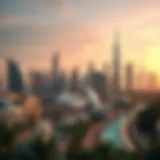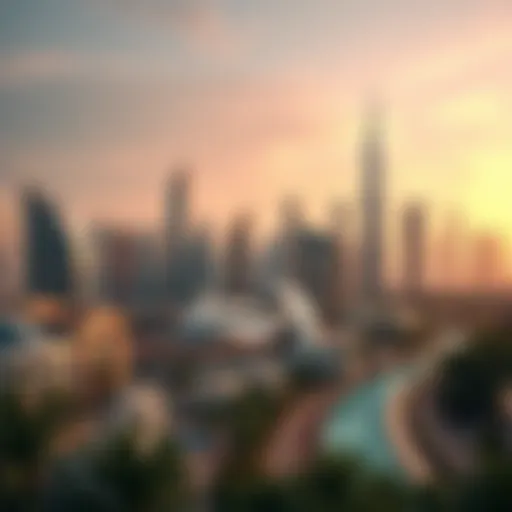Villa Construction in Dubai: A Comprehensive Guide
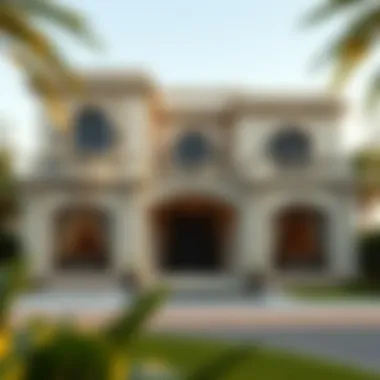
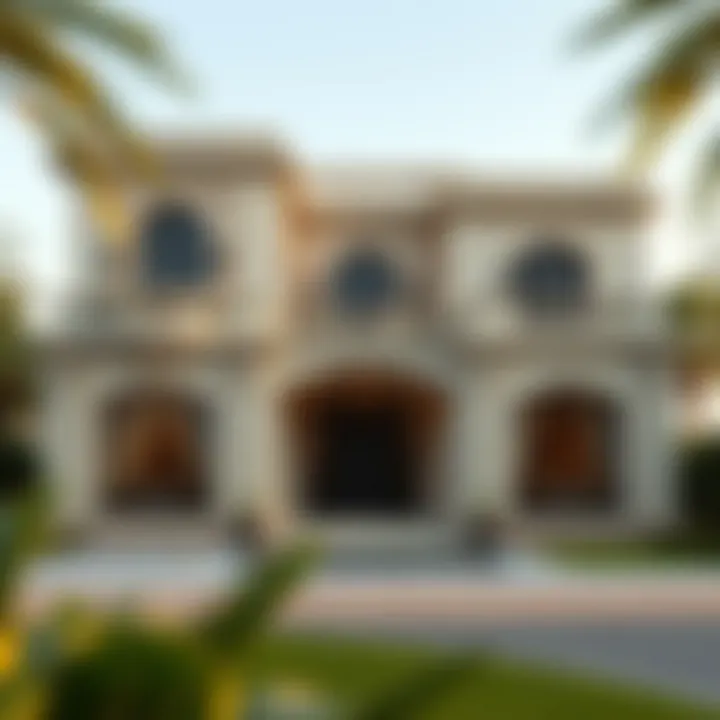
Intro
Villa construction in Dubai represents not only a significant aspect of real estate but also a reflection of luxury living that attracts attention worldwide. The vibrant market here offers opportunities for both seasoned investors and first-time homebuyers. This guide aims to unpick the layers surrounding villa construction, matching architectural styles with legalities and investment patterns that influence this booming sector.
In a city where innovation showcases a grand tapestry of culture and modernity, every villa portrays a story of creativity and function. It's crucial to understand the nuances of this market, from the prominent architectural styles that grace the skyline to the investment potential that can turn a property into a lucrative asset.
We will navigate through key considerations in villa construction, explore property listings, current market insights, and profiles of various neighborhoods. Whether you are an expatriate looking for your dream home, a real estate agent mapping out potential listings, or a property developer strategizing your next project, this guide is tailored to cater to your needs. The intricate dynamics of this market can be quite a handful, but with the right information, building or investing can turn from a daunting task into an exciting opportunity.
Join us as we delve deeper into the realm of villa construction in Dubai, where luxury meets practicality, and dreams find a solid foundation.
Overview of Villa Construction in Dubai
The villa construction market in Dubai holds a prominent position, showcasing not only architectural mastery but also representing a microcosm of this vibrant city’s economic growth and cultural aspirations. With millions drawn to its golden sands and glistening skyscrapers, the demand for luxurious living spaces has soared. This overview serves as a critical primer for understanding what drives villa construction in one of the world’s most exclusive markets.
Historical Context
Villa construction in Dubai can be traced back to the city's evolution from a modest trading port to a global metropolis. Initially, residential designs were simple, often resembling traditional Arab houses with an emphasis on functionality. However, as Dubai began to attract international attention in the late 20th century, architectural styles began to diversify significantly.
In the early 2000s, with the launch of numerous mega-development projects, the landscape of villa construction shifted dramatically. Iconic examples like The Palm Jumeirah and Arabian Ranches arose, establishing new benchmarks for luxury living. The melding of modern design with cultural elements has become a hallmark of Dubai’s villa architecture, which now accommodates a variety of styles, from classic Arabian to ultra-modern aesthetics.
Current Market Landscape
In today's real estate scene, Dubai boasts an eclectic assortment of villa projects. Each undertaking inevitably reflects the unique demands of a diverse clientele that includes both expatriates and affluent locals. The market is characterized by several key trends:
- Luxury and Customization: Buyers are searching for tailored specifications that cater to personal taste and lifestyle, thus driving developers to offer bespoke villa options.
- Sustainability Commitment: An increasing number of projects incorporate green building practices that cater to environmentally conscious buyers. This aligns with broader UAE initiatives aimed at sustainability.
- Financial Incentives: The local government has implemented reforms to attract foreign investment, contributing to burgeoning interest in both purchasing and building villas.
Investors typically observe an annual growth rate that signifies a healthy investment climate. Not only do villas in prime locations offer a future of high resale value, but they also stand as status symbols, reflecting the lifestyles many aspire to.
"Dubai’s villa market is not just about living; it embodies a lifestyle that combines opulence with innovation."
The combination of cultural influences, economic incentives, and state-of-the-art infrastructure makes Dubai a canvas for architectural excellence. For investors and homebuyers alike, understanding these dynamics is essential for navigating the complexities of villa construction in this remarkable city.
Architectural Styles Dominating Dubai Villas
When discussing villa construction in Dubai, the architectural style becomes more than just an aesthetic choice; it reflects cultural narratives and influences in a rapidly evolving urban landscape. Architectural styles in Dubai villas are not only about visual appeal but also about functionality, cultural resonance, and sustainability. As the skyline changes and construction techniques evolve, understanding these styles can significantly benefit investors and homeowners alike, shaping both decision-making and expectations.
Traditional Emirati Design
Delving into the roots of villa architecture in Dubai, traditional Emirati design stands out with its rich heritage and cultural significance. This style often features spacious courtyards, sturdy walls, and intricate geometric patterns, all representing the essence of local architecture shaped by the harsh desert climate.
- Materials Used: Clay, limestone, and coral are frequently used in constructing these homes, which help in reflecting the natural surroundings and maintaining a cooler indoor environment.
- Design Features: Traditional villas often incorporate wind towers (barjeel) that help cool homes naturally, making them energy-efficient. These homes focus on privacy, with designs directing attention inward towards stunning courtyards, creating a peaceful retreat away from the bustling city.
- Cultural Reflection: This architectural style celebrates the values of family and community, as homes designed in this manner typically accommodate large families and gatherings, an important aspect of Emirati culture.
Contemporary Architecture
Contemporary architecture has made significant strides in Dubai, marrying the demands of modern living with innovative design principles that redefine the village landscape. The popularity of contemporary styles reflects a shift towards minimalism and functionality while still embracing luxury.
- Design Characteristics: Clean lines, open floor plans, and large glass panels define contemporary villas, allowing for abundant natural light and fostering a sense of openness. The blending of indoor and outdoor spaces is commonplace, promoting a lifestyle that thrives on the beautiful Dubai climate.
- Sustainability: Contemporary architecture often prioritizes sustainability, using renewable energy technologies and eco-friendly materials. Solar panels, green roofs, and natural ventilation techniques are common features designed to reduce the carbon footprint of new builds.
- Visual Appeal: Bold, striking designs often feature cantilevered structures and innovative use of materials, from polished concrete to high-quality wood, contributing to an impressive skyline that captures the essence of modernity.
Sustainable Building Practices
With an increasing global focus on environmental conservation, sustainable building practices are rapidly becoming a cornerstone in villa construction. Dubai is no exception, as homeowners and developers recognize the importance of eco-friendly design in villa architecture.
- Green Materials: The use of sustainable materials such as recycled steel, bamboo, and energy-efficient insulation reduces waste and energy consumption during construction. These materials are not only beneficial for the environment but often result in reduced long-term maintenance costs.
- Water Management Systems: Villas are increasingly being designed with water conservation in mind. Smart irrigation systems, rainwater harvesting, and greywater recycling facilities are being integrated into villa designs to promote responsible water usage in the desert climate.
- Regulatory Support: The Dubai government encourages sustainable construction practices, offering incentives and guidelines for developers who prioritize eco-friendly approaches. This is not just beneficial for the environment, but it can also increase property values as sustainability becomes a significant selling point in real estate.
"Sustainable design is not just a trend; it is a necessity that caters to both contemporary aesthetics and the pressing need to protect our environment."
Key Considerations in Villa Design
Villa design goes beyond mere aesthetics; it’s a harmonious blend of functionality and visual appeal. Several key factors come into play when designing a villa that resonates with luxury, comfort, and practicality. Understanding these elements is crucial for anyone venturing into the complex world of villa construction in Dubai. The intricacies of legalities, market demands, and cultural expectations add layers of consideration that greatly impact the overall design process.
Space Optimization
Space optimization refers to the efficient use of physical space, ensuring that every square inch serves a purpose. In a city like Dubai, where property is at a premium, thoughtful design can turn a modest area into a spacious oasis. This concept involves meticulous planning of layouts to create open, inviting areas while also allowing for private spaces.
One effective approach is the open floor plan. By removing unnecessary walls between living spaces, designers can enhance natural light flow, creating an inviting atmosphere. This fluid spatial design not only boosts aesthetic value but also encourages social interactions among family members and guests.
However, space optimization isn't just about the layout; it’s also about adaptability. High ceilings, large windows, and outdoor integration (like balconies and terraces) can extend the feel of space significantly. Here are a few tips to optimize space effectively:
- Use Multi-Functional Furniture: Investing in furniture that serves dual purposes helps maximize utility. For instance, a sofa that converts into a bed can accommodate guests without compromising living space.
- Incorporate Vertical Storage: Utilizing wall-mounted shelves or tall cabinets can free up floor area while providing ample storage.
- Design with Flow in Mind: Ensuring smooth transitions between rooms prevents the feeling of clutter and enhances the overall livability of the villa.
"In the heart of every well-designed space lies the secret of space optimization. It’s not just about filling space, but about creating environments that feel right."
Interior Design Trends
The interior design landscape is ever-evolving, and when it comes to villas in Dubai, the latest trends reflect not just aesthetic preferences but also cultural nuances and lifestyle aspirations. Current interior design trends allow homeowners to create unique living spaces that echo personal styles while adhering to functionality.
Minimalism remains a popular choice, emphasizing clean lines and a clutter-free environment. This trend lends itself particularly well to Dubai's modern architectural styles, blending effortlessly with large windows that invite the stunning landscape into the home. Neutral palettes punctuated with pops of color can create a serene yet dynamic environment.
On the other hand, the fusion of traditional Emirati elements with contemporary finishes stands out as a hallmark of luxury. Incorporating local patterns, textiles, and artwork not only pays homage to the region's rich heritage but also adds depth and character to the living spaces.
Here are some trending interior design elements for villas:
- Natural Materials: Wood, stone, and leather lend an organic touch that's both inviting and stylish.
- Smart Technology Integration: Modern villas increasingly incorporate smart home systems, controlling everything from lighting to climate, creating a synergistic blend of luxury and convenience.
- Biophilic Design: This approach harmonizes indoor and outdoor environments, emphasizing natural light and plants. Features like indoor gardens or green walls can significantly enhance the aesthetic and well-being of residents.
Legal Framework for Villa Construction
Understanding the legal framework surrounding villa construction in Dubai is essential for anyone looking to invest in this bustling real estate market. Laws and regulations can be particularly intricate, often impacting project timelines, costs, and even the viability of building in certain areas. This section aims to shed light on crucial elements such as land ownership laws and the permitting process, which are both fundamental to navigating the villa construction landscape effectively.
Land Ownership Laws
The laws regarding land ownership in Dubai are unique compared to many global markets. Primarily, in Dubai, there are distinctions between freehold and leasehold properties. Freehold ownership allows buyers to own land outright and is largely available in designated areas; this invites expatriates to invest and build without the fear of losing title.

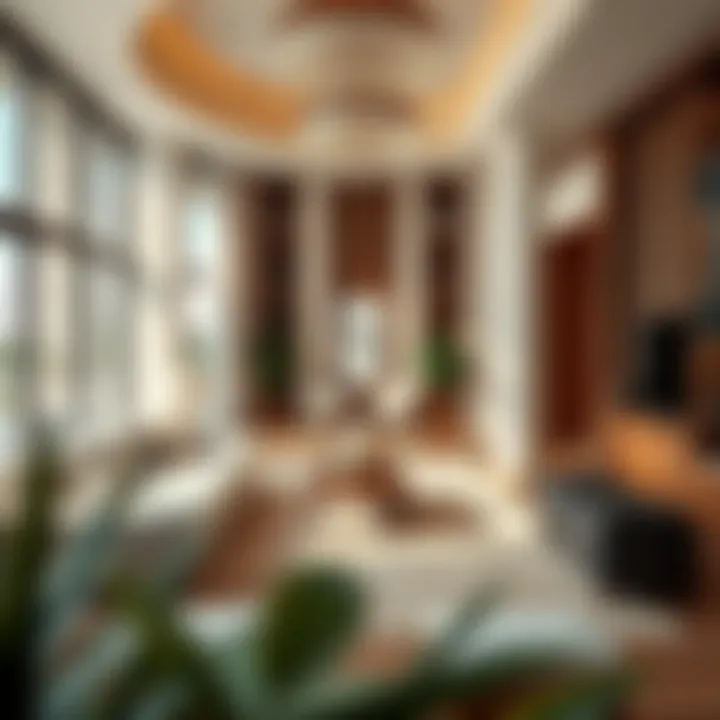
On the other side, leasehold properties typically offer a duration-based ownership model, which may span from 30 to 99 years. While this can appear less attractive to some investors, it remains a common route, especially in developments where the land is owned by a corporation or government.
Key highlights of land ownership laws includes:
- Freehold Areas: Check areas such as Dubai Marina and Palm Jumeirah for freehold opportunities.
- Leasehold Terms: Make sure to understand the conditions set by the property’s owner or developer.
- Regulatory Bodies: The Dubai Land Department governs transactions, ensuring all dealings comply with regional laws and standards.
“Navigating land ownership laws requires a keen understanding of local regulations, which can often become a puzzle for foreign investors.”
Awareness of these laws is not just beneficial, it's imperative. Violating ownership laws, even inadvertently, can lead to costly repercussions or project delays. Anyone engaging in villa construction must initiate due diligence before proceeding to ensure compliance with all regulations.
Permitting Process
Once you have a grip on land ownership, the next significant hurdle is the permitting process. Getting the right permits is akin to holding a key that opens the door to your construction site. Without the necessary approvals, construction can come to a grinding halt, wasting both time and money.
The process typically involves several stages:
- Initial Application: Submit the proposed villa design and site plans to relevant authorities for preliminary approval.
- Technical Review: Authorities will conduct a thorough review of the architectural plans to ensure compliance with safety, zoning, and environmental regulations.
- Final Approval: Once the technical review clears, you'll be granted the construction permit.
- Inspections: During construction, various inspections will occur to verify adherence to the approved specifications.
Given the complexity of this process, it might be prudent to work with a local consultant or legal expert in the field who understands the ins and outs of obtaining permits in Dubai.
Important aspects to consider during the permitting process include:
- Thorough Documentation: Much like cooking, assembling all required documentation is essential to avoid delays—a missing signature can be the difference between a go-head and a setback.
- Timeline Awareness: Building permits can take anywhere from a few weeks to several months, depending on the project's size and complexity.
- Engagement with Authorities: Establishing a good rapport can streamline interactions; after all, a little networking can go a long way.
Financing Villa Projects
Financing villa projects in Dubai is a topic of considerable importance, especially given the rapid growth of the real estate sector in the region. Those looking to invest in luxurious villas must understand the financial landscape, as it shapes not only how projects are funded but also how they gain traction in a competitive market.
The financial outlay required for villa construction can be daunting, but securing the right financing is not just about money—it's about vision, strategy, and understanding the economic pulse of the area. This part of the city showcases not only stunning architectural offerings but also notable investment opportunities. Each villa tells a story; thus, their funding options are critical to allowing that narrative to unfold.
Investment Opportunities
Investors can find a wealth of opportunities in Dubai's villa market. The city's robust economy, combined with a rising population and an increasingly affluent expatriate community, creates a fertile ground for investment. Notably, luxury real estate in Dubai has demonstrated strong appreciation rates, making it an attractive option for both local and international investors.
- Diverse Market Segments: From ultra-luxurious beachfront villas in Palm Jumeirah to exclusive gated communities like Emirates Hills, options abound. Understanding which segment aligns with your investment strategy can lead to significant returns.
- Government Initiatives: The Dubai government's efforts to attract foreign investment, such as the introduction of long-term visas, enhances the appeal of investing in villas. These policies create a more stable investment environment.
- Rental Yields: For many investors, rental income is a key consideration, and villa rentals can yield impressive returns, particularly in sought-after locations.
"Investing in Dubai’s villa market not only offers a chance for impressive returns, but also the opportunity to engage with a diverse community and lifestyle."
Banking Options
Financing through banks in Dubai has become increasingly sophisticated, catering to the needs of both local and expatriate buyers. Several factors influence the banking options available for villa construction projects.
- Mortgage Options: Many banks and financial institutions offer a variety of mortgages specifically designed for purchasing property. These loans can be tailored for expatriates and local individuals alike, often featuring competitive interest rates.
- Loan-to-Value Ratios: Typically, banks may offer a loan-to-value ratio (LTV) of up to 80% for expatriates, while Emirati citizens might enjoy slightly more favorable terms. Knowing these ratios helps in planning your financial investment thoughtfully.
- Flexible Payment Plans: Several banks accommodate flexible payment schedules, allowing investors to manage cash flow better and align it with project timelines.
- Regulatory Compliance: It’s crucial to ensure compliance with the UAE Central Bank’s regulations when seeking financing. Being aware of these procedures can prevent unexpected hurdles down the line.
Consider consulting with financial advisors or agencies such as Dubai Land Department or RERA to review the available financing options and their implications on villa project investment. Understanding the landscape will empower prospective investors to make informed decisions that lead to successful villa construction projects.
Choosing the Right Contractors and Suppliers
Selecting the right contractors and suppliers is one of the cornerstones of successful villa construction in Dubai. This critical choice not only influences the quality of the build but also affects timelines, costs, and long-term satisfaction of the property. In a market as competitive as Dubai’s, a meticulous approach can set the difference between a dream home and a financial headache.
Evaluating Contractor Credentials
Before entering contracts, it’s crucial to assess a contractor’s credentials thoroughly. A well-respected contractor should boast the right qualifications, such as licenses, insurance, and established experience in the local market. Ask for a portfolio showcasing previous projects, which can provide insight into their range of work and the quality they deliver.
- Licenses and Certification: Ensure that they are licensed to operate in Dubai and hold any additional relevant certifications. Check if they've successfully navigated similar projects.
- Reputation and Reviews: Talk to former clients and watch for online reviews. Social media can also provide a real-world glimpse into their reliability. Websites like redfin.com or yelp.com may have real feedback to offer.
- Financial Stability: Confirm that the contractor has solid financial footing. A financially unstable contractor can lead to stalled projects or increased costs due to mismanagement.
One way to evaluate potential contractors is through personal recommendations from fellow expatriates or friends who have successfully built villas in Dubai. Sometimes, word of mouth can reveal insights that Google searches won't.
“Choosing the right contractor is akin to selecting the right architect; both are essential for turning dreams into brick and mortar.”
Material Sourcing Challenges
Once a contractor is on board, the next hurdle often lies in sourcing materials essential for construction. Dubai's vibrant market does offer a variety of options, but this abundance can lead to challenges in terms of quality, price, and timelines.
Several factors can complicate the material sourcing process:
- Quality Control: Not all materials are created equal. It’s important to ensure that the supplier adheres to industry standards. Cheap materials can compromise the durability of your villa.
- Import Regulations: If your materials are sourced from abroad, be prepared for potential delays due to customs regulations. Understanding local rules can save time and frustration.
- Cost Fluctuation: Prices for materials can vary widely based on market demand. It can be prudent to lock in prices when you find a favorable deal, yet flexibility may be necessary as projects can sometimes face unexpected delays.
Additionally, consider engaging with local suppliers who understand market trends and can respond quickly to evolving needs. This not only ensures timely delivery but often fosters a relationship that can be beneficial in the long run.
Navigating the Construction Phase
The construction phase is a pivotal moment in the journey of creating a villa in Dubai. This stage transforms plans on paper into an actual living space. It is crucial not only for the end result but also for managing costs, timelines, and quality. Knowing how to navigate this phase effectively can mean the difference between a seamless build and a project fraught with issues.
A successful construction phase can be influenced by several factors, including robust project management and stringent quality control measures. Here’s an in-depth look at these essential components.
Project Management Techniques
Effective project management acts as the backbone of villa construction. The art of orchestrating various elements—teams, schedules, materials—requires finesse. Here are some key techniques that can help streamline the process:
- Establish Clear Objectives: Setting defined goals is the first step. Ensure all stakeholders understand the project scope, budget, and timelines. A clear vision helps align everyone’s efforts.
- Utilize Project Management Software: Tools like Trello or Asana enable real-time tracking. These platforms help keep tabs on progress and allocate resources efficiently. Having a digital roadmap is invaluable.
- Regular Meetings and Communication: Frequent check-ins with contractors, suppliers, and team members ensure everyone remains on the same page. Miscommunication can lead to costly delays.
- Set Milestones: Breaking down the project into manageable milestones allows for monitoring progress. This approach creates motivation, as each completed stage brings a sense of accomplishment.
"Good project management is not just about keeping track; it's about keeping ahead."
- Risk Management Planning: Identify potential risks and create a contingency strategy. Whether it's delays due to bad weather or supply chain hiccups, being prepared will save time and money.
Quality Control Measures
Quality and durability are non-negotiable in villa construction. Ensuring these elements remain high requires the implementation of strong quality control measures throughout the construction phase. Here are several methods to enhance quality assurance:
- Material Inspection: Before using any materials, conduct thorough checks to ensure they meet specified standards. For example, ensuring that concrete meets the required compressive strength can prevent structural issues down the line.
- Regular Site Inspections: Arrange for routine inspections at various stages of construction. Independent quality inspectors can pinpoint issues early, thereby preventing costly corrections afterward.
- Implement Checklists: Create comprehensive checklists for each construction stage. This structured approach guarantees that all tasks are completed and nothing falls through the cracks.
- Document Everything: Keeping detailed records of all tests, inspections, and communications ensures transparency. This documentation is crucial should any disputes arise later.
- Post-Completion Reviews: After construction wraps up, conducting a thorough review can uncover any lingering issues. This step also serves as a baseline for future projects.
Navigating the construction phase with meticulous care and attention to detail sets the foundation for a successful villa project. Both project management techniques and quality control measures play significant roles in ensuring that the building process not only meets expectations but exceeds them. Knowledge of these crucial elements will serve investors, developers, and homeowners well in the competitive Dubai market.

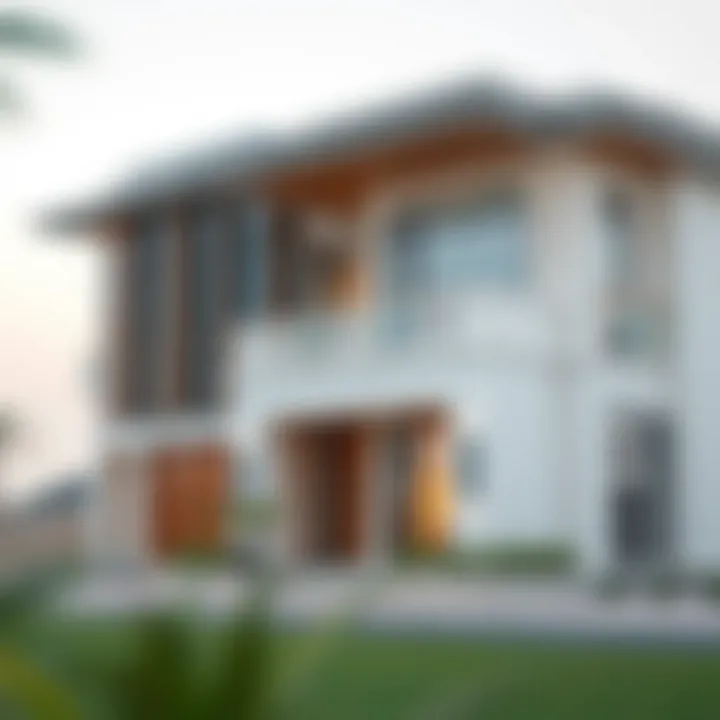
For further reading on construction best practices, consider consulting resources such as Wikipedia, Britannica, and other construction management resources.
Post-Construction Considerations
Post-construction is when the rubber meets the road, especially in the villa construction game in Dubai. Once the hammers fall silent and the last screw goes in, the real work often begins. Proper post-construction planning ensures that the investment continues to grow, but it doesn’t end there. Taking care of a villa requires a solid approach to maintenance and an eye on its future resale potential.
Property Maintenance
Maintaining a villa is much like tending to a garden—it needs regular attention to flourish. Property maintenance in Dubai involves several components, from structural integrity to aesthetics. Climate here can be tough with scorching heat and occasional dust storms, so it is crucial to stay proactive in upkeep.
- Regular Inspections: Keep an eye out for wear and tear such as cracks in walls, leaks, or other damages. Regular inspections can catch small issues before they grow into costly repairs.
- Landscaping: The yard is the first thing people see. Keeping it neat not only boosts curb appeal but also keeps plants healthy amidst the warm climate. Incorporating native plants can reduce water needs.
- HVAC Systems: In a city that rivals an oven, the HVAC system is a lifeline. Make sure to schedule regular maintenance checks to ensure it's running efficiently, because when the temperature rises, comfort is key.
- Smart Systems: Using smart technology can assist in monitoring your villa’s various systems, from security to energy efficiency. These systems often provide alerts when issues arise, allowing you to address problems promptly.
Keeping these aspects in check not only preserves the value of the property but also enhances the quality of life for its inhabitants.
Market Resale Potential
When it comes to real estate, you could say it's a jungle out there. Understanding the market resale potential is essential for anyone throwing down serious cash on a villa. The dynamics of the luxury villa market in Dubai can work in your favor, if you play your cards right.
- Location: This often trumps all other factors. Villas in desirable neighborhoods or near popular amenities can fetch high prices. Areas like Palm Jumeirah or Downtown Dubai are prime spots that attract buyers.
- Trends in Design: Keeping track of architectural trends can make a big difference. Buyers are increasingly looking for modern designs that incorporate sustainability and smart technology. If your villa aligns with these trends, you're likely to see better offers when it’s time to sell.
- Market Climate: Annual fluctuations in the market can significantly impact resale value. Staying informed about market trends, such as buyer demand and interest rates, can help you strategize when to put your villa on the market.
"The key to maximizing resale value is staying ahead of the market’s expectations."
In summary, by ensuring your villa gets the necessary maintenance and keeping a keen eye on resale potential, you can not only protect your investment but also open doors to lucrative opportunities in Dubai’s evolving real estate landscape.
The Role of Smart Home Technology
Smart home technology has become a significant aspect of villa construction in Dubai, transforming the way homeowners interact with their living spaces. In recent years, the lines between luxury and technology have blurred, with smart systems becoming not just an enhancement but a necessity. This integration is not merely about convenience; it’s a matter of safety, efficiency, and overall quality of life. As property developers and investors look for cutting-edge solutions, understanding the implications and opportunities that smart technology presents is crucial.
Integration of Smart Systems
When constructing a villa equipped with smart home technology, integrating systems becomes a priority. This includes smart lighting, heating, and security systems, all of which connect through a central hub. Homeowners often prefer systems that can be controlled via smartphones or automated through schedules to streamline their daily routines. For instance, you may want your lights to dim as the evening sets in or your air conditioning to adjust as you arrive home from work.
Moreover, incorporating smart systems early in the design phase can avoid costly retrofits later on. If you aim for maximum efficiency, coordinating with architects and contractors on wiring for smart devices is essential.
- IoT Devices like thermostats and security cameras can communicate with your central system. They can learn your preferences and adjust accordingly, making the house smarter over time.
- Centralized Control Systems provide a seamless interface for controlling various elements of your home, from audio-visual to climate.
Considerations for integration include:
- Ensuring compatibility of devices from various manufacturers.
- Planning for adequate bandwidth to support multiple devices, as poor connectivity can lead to frustrations.
- Selecting a reliable security protocol to protect your home network from cyber threats.
Benefits of Automation
The benefits of automating a villa through smart technology extend far beyond mere whims of convenience. An automated home not only enhances the quality of daily life but can also significantly increase property value.
"Investing in smart home technology provides a competitive edge in the luxury villa market, appealing to tech-savvy buyers who value convenience and efficiency."
A few key benefits include:
- Energy Efficiency: Smart thermostats and energy-efficient lighting can lead to reduced utility bills. They adjust based on occupancy, ensuring that energy is not wasted.
- Enhanced Security: Automated locks and surveillance systems offer both peace of mind and increased safety, allowing homeowners to monitor their property from anywhere in the world.
- Convenient Control: Homeowners can control various aspects of their homes remotely, whether it be adjusting the temperature, checking security cameras, or even watering the garden.
- Improved Home Management: Integration of voice-controlled devices makes managing everyday tasks a breeze. From playing music to setting reminders, homeowners can manage their homes with simple voice commands.
Emerging Trends in Villa Construction
The landscape of villa construction in Dubai is ever-evolving. Innovations in materials, design philosophies, and building methodologies are shaping the way luxurious homes are created. Understanding these emerging trends can significantly benefit potential investors, property developers, and homebuyers as they navigate this competitive market.
Eco-Friendly Materials
With increasing awareness of environmental issues, there is a marked shift towards utilizing eco-friendly materials in villa construction. These materials not only lessen the ecological footprint but also enhance the long-term sustainability of the properties.
The benefits of using eco-friendly materials are manifold:
- Reduced Carbon Footprint: Materials like bamboo, recycled steel, and sustainably sourced wood help in lowering emissions compared to conventional materials.
- Energy Efficiency: Green materials often come with better insulating properties, leading to reduced energy consumption in heating and cooling.
- Healthier Living Environment: Many eco-friendly materials do not emit harmful toxins, creating a healthier atmosphere for occupants.
Additionally, local governments might provide incentives for projects utilizing sustainable materials, an angle which can further enhance the attractiveness of investments in villas. It's crucial to assess the availability of these materials in the local market during the planning phase, ensuring that they align with both the budget and aesthetic aspirations of the project.
"Investing in eco-friendly materials is not just a trend; it reflects a shift in priorities towards sustainable living and responsible construction practices."
Modular Construction Approaches
Another notable trend gaining traction in Dubai's villa construction scene is the use of modular construction techniques. This method involves prefabricating sections of the villa in a controlled factory environment before assembling them on-site.
The advantages accompanying modular construction are significant:
- Time Efficiency: Assembling pre-built modules can dramatically reduce the construction timeline, allowing homeowners to occupy their villas sooner.
- Cost-Effectiveness: Streamlined processes translate into lower labor and material costs. In a city known for premium pricing, this is a compelling benefit.
- Design Versatility: Modular buildings allow for customized design options, giving homeowners the flexibility to personalize their spaces according to individual needs and preferences.
However, there are considerations to keep in mind when leaning towards modular construction. It's essential to work with reputable contractors experienced in this methodology to ensure that the final structure maintains high quality and adheres to local building codes.
Cultural Impacts on Villa Design
The significance of cultural influences on villa design in Dubai cannot be overstated. As a melting pot of traditions and modernity, Dubai presents a unique landscape for architecture that reflects its diverse population and rich heritage. When constructing a villa, understanding these cultural contexts becomes essential not just for aesthetics but also for ensuring the functionality and acceptance of the space in the community. The design of a villa isn’t merely about luxurious finishes or expansive layouts; it’s about weaving a narrative that resonates with both locals and expatriates.
Cultural Sensitivity in Architecture
In a city characterized by its rapid development, cultural sensitivity is crucial. This means acknowledging and respecting the values, beliefs, and practices of the varied communities that reside here. For instance, the architectural choices made in residential projects must consider privacy, family dynamics, and social gatherings, which are often central in Emirati culture. Villas designed with traditional courtyard layouts allow for family gatherings while providing a shield from the public eye.
Moreover, structures that incorporate elements like mashrabiya — intricately carved wooden screens — serve dual purposes; they not only reflect aesthetic appeal but also uphold cultural norms regarding privacy. Architects and designers are increasingly using local materials and vernacular styles to emulate traditional aesthetics while infusing modern comfort. This delicate balance ensures that the villa feels at home in its environment, fostering community pride and cohesion.
"An architect's job isn't just about building; it's about creating a dialogue between the past and the future."
Influence of Global Design Trends
As international design trends continually evolve, they increasingly permeate villa construction in Dubai. The influence of global styles is profound, as architects draw inspiration from various sources to create unique, eye-catching homes. However, it is important to blend these innovative ideas with local cultural elements.
For instance, while open-plan layouts and glass facades are popular worldwide, their application in Dubai must take into account the local climate and cultural practices. Cool, shaded spaces and indoor-outdoor living are reworked designs that cater to both comfort and traditional values. The careful integration of sustainable technologies marries these modern designs with the need for environmental consciousness, creating homes that are as energy-efficient as they are beautiful.
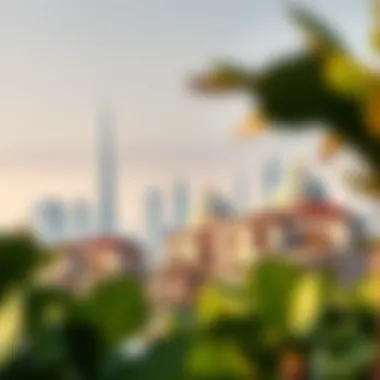

In essence, the future of villa design in Dubai lies in this amalgamation of influences. Developers and architects will benefit from understanding both local customs and global movements, creating spaces that not only attract buyers but also honor the region's identity.
Community Living in Dubai
In recent years, Dubai has evolved into a vibrant metropolis featuring a tapestry of cultures, lifestyles, and residential options. The allure of community living resonates deeply in this dynamic city, where expatriates and locals alike are drawn to the modern conveniences and secure environments found within gated communities. Community living not only enhances the quality of life but also encourages social interactions, fostering a sense of belonging among residents.
The essence of community living encapsulates several key elements: accessibility, security, and a plethora of amenities that cater to the diverse needs of its residents. One cannot understate the importance of these aspects, especially in a city as diverse and rapidly evolving as Dubai. As families and individuals seek neighborhoods that offer both comfort and interaction, the concept of community living blossoms as a highly attractive option.
Amenities and Services
One major draw of community living in Dubai is the array of amenities and services that these neighborhoods tend to offer. Many gated communities feature:
- Swimming pools and fitness centers that encourage an active lifestyle.
- Parks and play areas designed for families and children.
- Retail outlets and dining options that provide convenience within walking distance.
- Security services that enhance the peace of mind for residents, making them feel safe in their homes.
- Community events that foster connections among neighbors, from social gatherings to holiday celebrations.
Living in such well-equipped environments presents immense benefits, especially for families with children, who can enjoy a holistic lifestyle that marries leisure and wellness. Community amenities create a more organized and enjoyable living experience, allowing residents to engage with their surroundings and connect with others more readily.
Social Dynamics in Gated Communities
Understanding the social dynamics within gated communities in Dubai unveils a complex yet fascinating layer. These environments are often characterized by a unique blend of cultures, as people from various backgrounds coexist and interact. This multicultural aspect enriches the community experience, creating opportunities for learning and collaboration.
Life in gated communities encourages interaction among neighbors, which can significantly enhance relationships. Often, residents participate in:
- Neighborhood watch programs, promoting a sense of security and camaraderie.
- Interest-based clubs such as book clubs, sports teams, or gardening groups that encourage residents to bond over shared passions.
- Volunteer initiatives that contribute positively to the broader community, reflecting a collective spirit of giving back.
However, navigating the social dynamics may sometimes present challenges. New residents may feel overwhelmed or even isolated at first, as familiar connections take time to build. It's essential for communities to foster inclusivity, ensuring newcomers are welcomed with open arms.
"In community living, the beauty lies not just in the physical surroundings, but in the connections we forge and the lives we touch."
Investing in Luxury Real Estate
In the bustling real estate market of Dubai, investing in luxury villas becomes not just a financial decision but also a lifestyle choice. With its sprawling deserts juxtaposed against modern skyscrapers, Dubai offers a unique blend of cultures, profits, and investment potential. The luxury villa sector stands out, attracting individuals with a keen eye for aesthetics as well as a nose for profitable ventures. Investing in such properties isn’t merely about securing a place to call home; it’s about positioning oneself within a rapidly growing market, often regarded as a gold mine for discerning investors.
Market Analytics and Forecasts
Understanding the nuances of the luxury villa market in Dubai requires a comprehensive look at current trends and future projections. Recent reports have indicated that the demand for high-end residential properties remains robust, fueled by a growing expatriate population and an influx of foreign investments. Real estate agents and property developers have observed an uptick in inquiries for lavish villas, particularly those boasting innovative designs and state-of-the-art amenities.
- Market Demand: The appetite for luxury villas continues to rise, propelled by both domestic buyers and international investors. A significant share of buyers comes from countries such as India, the UK, and Russia.
- Price Trends: Previously, luxury properties saw fluctuating prices, but stability has been noted recently, indicating a maturation of the market. With median property prices in Dubai seeing gradual increases, investing now could yield substantial returns in the long run.
- Future Outlook: Experts project a steady rise in luxury real estate prices over the next few years. Factors influencing this include favorable laws for foreign investments and the expanding infrastructure that enhances the livability of Dubai.
"Investing in luxury real estate in Dubai has become a strategic move for many, as the market exhibits resilience and potential for growth."
Role of Foreign Investment
When discussing the dynamics of luxury real estate in Dubai, the role of foreign investment cannot be overstated. Over the last decade, Dubai's government has implemented numerous initiatives to attract overseas investors. This has not only infused capital into the local economy but has also enhanced the global reputation of the Emirate as a prime real estate destination.
- Investment Incentives: The introduction of long-term visas for property buyers has made Dubai increasingly appealing. This policy change encourages foreign investors to see the city not just as a playground, but as a viable option for residency.
- Diversification of the Portfolio: For many high-net-worth individuals, investing in Dubai luxury villas provides an excellent opportunity to diversify their real estate portfolios. The trend reflects a pathway to mitigate risks associated with economic downturns in their home countries.
- Impact on Local Economy: Foreign investments have led to job creation and development in various sectors, beyond just real estate. The construction industry, in particular, has benefited, contributing to a boom in the local economy.
In summary, investing in luxury real estate in Dubai is laden with opportunities, driven by robust market analytics and a welcoming environment for foreign investments. By understanding these dynamics, potential investors can make informed decisions that pave the way for lucrative outcomes in one of the world’s liveliest real estate hubs.
Case Studies of Successful Villa Projects
In the bustling real estate arena of Dubai, case studies of successful villa projects serve an essential purpose. They provide not only inspiration but also valuable lessons that prospective investors and homeowners can leverage. Understanding the journey behind these developments—from inception to execution—enables stakeholders to grasp the intricacies involved in luxury construction and design. Additionally, these studies highlight best practices, innovative approaches, and potential pitfalls to avoid.
Specific Elements and Benefits
To grasp the significance of case studies in villa construction, consider these points:
- Real-World Insights: Case studies embody practical knowledge. They reflect real-life challenges encountered and solutions implemented.
- Benchmarking Standards: They can guide emerging developers in setting and achieving high standards that match Dubai’s luxury market.
- Inspirational Design Features: Unique architectural styles and cutting-edge technologies showcased in these projects often captivate potential buyers, encouraging them to invest.
"A successful villa project is not just about aesthetics. It’s about addressing functional needs, sustainability, and cultural relevance."
Innovative Designs and Features
When examining notable villa projects in Dubai, one can’t ignore the innovative designs and features that make them stand out. Each villa can be seen as a canvas for creative expression, combining functionality with artistry.
Some hallmark features often seen are:
- Biophilic Design Elements: Incorporating natural materials and greenery blurs the line between indoors and outdoors, fostering connection with nature.
- Smart Home Integration: Advanced systems for lighting, climate control, and security are often embedded into the architecture, reflecting a trend towards automation and convenience.
- Reflective Pools and Water Features: Many villas feature stunning pools that serve both aesthetic and recreational purposes, offering respite from the heat while enhancing the exterior beauty.
Such elements not only elevate the living experience but also add to a villa’s value, making these features invaluable for potential investors.
Challenges Overcome in Construction
Every ambitious project comes with its fair share of hurdles. The challenges overcome in construction of luxury villas in Dubai often reveal the tenacity and ingenuity of developers and contractors. Key obstacles might include:
- Regulatory Compliance: Navigating Dubai’s stringent building codes and regulations is no small feat. Successful projects often showcase their ability to comply with these standards while maintaining aesthetic appeal.
- Supply Chain Issues: The sourcing of premium materials can be a juggling act. Disruptions due to global events can cause delays. However, innovative project leaders find local substitutes or adapt to alternative sourcing strategies, ensuring timeliness.
- Cultural Sensitivity: Understanding the cultural backdrop is vital. Ensuring that the design resonates well with local customs and social norms often proves essential for market acceptance. Many successful project managers foster collaboration with cultural consultants to bridge gaps.
Guest feedback loops during construction are also key; they facilitate adjustments that cater to evolving homeowner preferences. Observations from luxury villa case studies serve as a valuable educational tool for future projects.
In sum, delving into these case studies not only broadens one's understanding of what it takes to build a successful villa but also unveils the dynamics at play in Dubai's luxury real estate sector.
Closure and Future Outlook
The realm of villa construction in Dubai stands as a vibrant testament to the city’s relentless pursuit of luxury and opulence. As we arrive at the conclusion of this comprehensive guide, it’s crucial to acknowledge that the future of villa construction in such a dynamic market is intertwined with innovation, sustainability, and cultural sensitivity. Each aspect discussed throughout this article—be it architectural styles, legal considerations, or emerging market trends—weaves into the very fabric of future prospects.
The ever-evolving landscape of the real estate market in Dubai presents not just opportunities, but also dilemmas that demand astute analysis and a forward-thinking mindset. Investors and developers must keep their fingers on the pulse of global design trends to capitalize on what could dictate future interest in high-end villas. To remain relevant, stakeholders should embed eco-friendly practices and smart technology into their projects, bridging luxury with sustainability.
One of the most significant elements on the horizon is the integration of technology within villa designs. This encompasses more than just aesthetic enhancements; rather, it's about creating smart homes that offer convenience and efficiency to residents. The appetite for intelligent living spaces is on the rise, particularly among expatriates and tech-savvy individuals looking for modern amenities alongside traditional charm. By marrying these technological advancements with cultural relevance, future villa projects can resonate profoundly with buyers.
As the world becomes increasingly interconnected, foreign investments in Dubai's luxury real estate sector are poised to grow. The Gulf region’s political stability and economic potential serve as additional factors that lend strength to its allure. Developers and real estate agents should actively seek to engage international clients, highlighting the unique lifestyle Dubai offers while understanding the nuances of diverse cultural preferences.
In essence, the future of villa construction in Dubai is painting an optimistic picture. While navigating through potential challenges, the blend of market analytics and cultural insights will empower stakeholders to create homes that are not just dwellings but symbols of a lifestyle.
"What is done with great love is done well," and the passion behind crafting villas in Dubai truly drives the success of this industry.
Whether you’re an investor, developer, or a potential homeowner, understanding these future trajectories offers a roadmap to not only engage with the market effectively but also to contribute meaningfully to the evolving narrative of luxury living in Dubai.
Summary of Key Insights
- Emphasis on sustainability and technology integration in villa designs is critical for future growth.
- The need for cultural sensitivity while addressing global design trends cannot be underestimated.
- The rise of foreign investments highlights Dubai's potential as a melting pot for luxury real estate opportunities.
Future Prospects for Villa Construction in Dubai
- Growth of Eco-Friendly Practices: As environmental awareness increases, more developers will incorporate sustainable building materials and methods into their designs.
- Rise of Technology-driven Homes: Integration of smart home systems promising efficiency and convenience will likely become standard in new villas.
- Strengthening Cultural Links: Projects that reflect the rich heritage of Dubai while catering to modern preferences will stand out in an increasingly competitive market.
- Evolving Investor Demographics: As international investors show heightened interest, the market may see diversification in buyer preferences and expectations.
- Enhanced Quality of Life Features: The demand for lifestyle-centric amenities such as health, wellness, and social spaces will shape future villa designs, aiming to create a holistic living experience.


